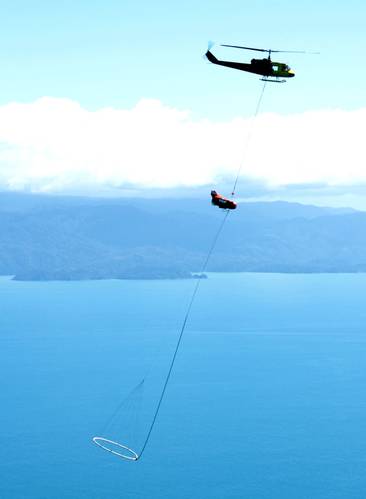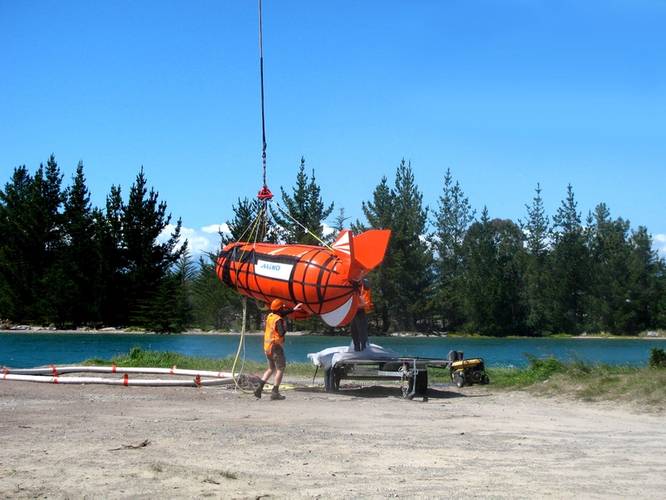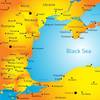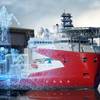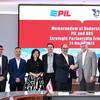Following a full product trial in New Zealand, the Norwegian Coastal Administration (NCA) has signed its acceptance of the first of two ShipArrestor systems from Miko Marine, making Norway the first country with a system that gives it the ability to protect its shores from the danger of drifting oil tankers and from the disastrous pollution that can result when they run aground.
The newly manufactured ShipArrestor was put through a complete customer acceptance trial in Tasman Bay, New Zealand using chartered helicopters and vessels. The system consists of a large fabric parachute-style sea anchor that is looped by a helicopter onto a ship drifting without engine power. This is achieved without any involvement of the ship’s crew after which a line terminating with the sea anchor in a container is paid-out upwind by the helicopter. When the container is dropped into the sea it releases the fabric anchor, a recovery line and a buoy that shows its location. The sea anchor cuts the speed of the ship’s drift and consequently increases the time available for a rescue tug to reach the ship and take it in tow before it runs aground and ruptures its tanks.
When the rescue tug arrives it can lift the buoy on board and use its line to tow the ship to safety. The advanced materials used by the ShipArrestor give it the strength and ability to quickly turn any size of ship, from a trawler to a supertanker, into the wind and halve the speed at which it is drifting. This also prevents the severe rolling that has been responsible for tankers such as the Prestige and the Erica breaking-up due to the stresses of lying side-on to the waves.
The ShipArrestor was developed by salvage technology specialists Miko Marine, which led a consortium of eight European organizations partly funded by the European Union. This included companies from France, Germany, Netherlands and Austria as well as the Norwegian Institute of Technology and the U.K.’s Ship Stability Research Centre which all applied their individual expertise to the challenge.
Coppins Sea Anchors Ltd of Motueka, New Zealand joined the team as co-developers of the ShipArrestor in early 2014. Bringing decades of experience in the development of large sea-anchors to the project, the company designed and manufactured the sea anchor and its deployment system and arranged for the final proving trial to take place. “This is one of the most challenging projects we have worked on in the last 40 years,” said Bill Coppins, general manager of the company. “It has tested our technology and resources to create such a lightweight but strong para sea anchor system that can be flown by helicopter. We are very excited and proud to be involved with the ShipArrestor system.”
Its success was such that the NCA confirmed its acceptance of the first ShipArrestor which is now on its way to Norway by sea freight. On arrival the Miko ShipArrestors will be stored on helicopter stations at Hammerfest above the Arctic Circle and at the Kystverket station at Fedje just north of Bergen. This will make them quickly available for use on a drifting ship anywhere along Norway’s 2000-nautical mile coast.
Ola Jordheim, NCA chief engineer and ShipArrestor project manager said, “We hope that we will never need to use our ShipArrestor systems but our experience suggests otherwise.”
Jordheim recalled several incidents around the coast of Norway where the system would have prevented ships coming to grief: “A notable one occurred in 2005 when the tanker Fjord Champion caught fire and lost power,” he said. “The crew had to evacuate the ship which subsequently ran aground on the southern tip of Norway. This is the sort of situation that ShipArrestor has been designed to prevent and we are looking forward to the delivery of the first of our two systems. Its arrival will be followed by a short training program for our personnel and for helicopter crews after which the ShipArrestor will be available to protect ships and our coastline. The unpredictable nature of maritime safety makes absolute guarantees impossible but the availability of the ShipArrestor now makes Norway unique in being the only country that has a means of protecting itself against a pollution disaster. ”
Nicolai Michelsen, general manager of Miko Marine added, “We are now very proud to be making the first delivery of a ShipArrestor. A great deal of technical research had to go into its development asthirty years ago the ShipArrestor would have been impossible to construct as many advanced materials that combine strength with lightnessare needed in its manufacture. It is only because these special fabrics and metals used are now available that the project was able to go ahead.”








